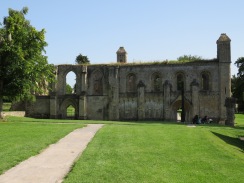Quite recently, Abbey directors, Chris and Jim Parker, embarked on a short “staycation” through Devon, Cornwall, Dorset and Hampshire. A real bucket list holiday which include some of the places they had wanted to go to, but never quite made it.
On the list was Port Isaac to hear the fisherman’s choir, the Eden project and lunch in a Rick Stein restaurant in Padstow. While they were planning their route they decided to go across county through Wiltshire to Somerset, where they made their first stop in Glastonbury, much to the delight of their grandchildren who all assumed they were off to the festival. Neither Chris nor Jim had ever been into Glastonbury town or visited the Abbey which was a real pilgrimage for a couple of funeral directors.
“The town is quite beautiful” Chris said, “but the Abbey is magical. We were amazed at how much of this ancient building is still standing and in such good condition. I came to the festival many years ago, but only got as far as Worthy’s farm. The teenage me wasn’t terribly interested in visiting a ruined abbey when The Who had more to offer”
The whole area is steeped in Arthurian myth and of course, there is a connection to St Joseph of Arimathea who is the patron Saint of funeral directors. He was, according to all four canonical gospels, the man who assumed responsibility for the burial of Jesus after his crucifixion.
His connection with Glastonbury goes back to the very earliest part of the first century, around 63AD when Joseph, who was a merchant, arrived in Britain. He is said to have landed on the island of Avalon and climbed up to Wyrral Hill.
Exhausted, he thrust his staff into the ground and rested. By morning his staff had taken root and grown into a thorn or rose bush. By the 16th century, not long before henry VIII’s Dissolution of the Monasteries, three thorn trees grew on Wyrral Hill just outside of the town of Glastonbu ry. The trees were very unusual because they flowered twice – once in the spring around Easter, and a second time at Christmas. Not surprisingly, they were seen as holy thorns. In the Civil Wars Puritan soldiers cut down the only remaining thorn because they saw it as an object of superstition
ry. The trees were very unusual because they flowered twice – once in the spring around Easter, and a second time at Christmas. Not surprisingly, they were seen as holy thorns. In the Civil Wars Puritan soldiers cut down the only remaining thorn because they saw it as an object of superstition
However, local people had kept cuttings, and it is from these that the thorn now growing in the abbey grounds, picture above) is believed to descend. It continues to flower around Easter and again at Christmas when,, each year, blooms are sent to Her Majesty the Queen to be included in the Royal Family’s Christmas Day table setting.
